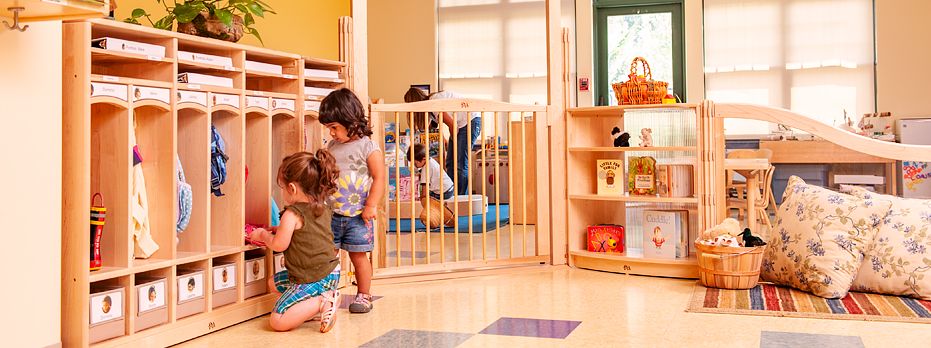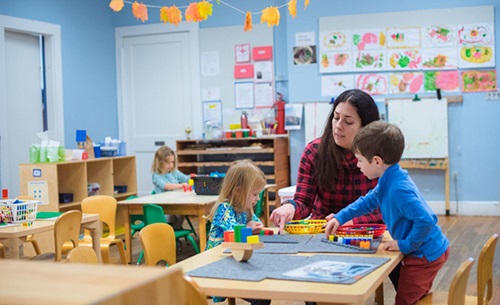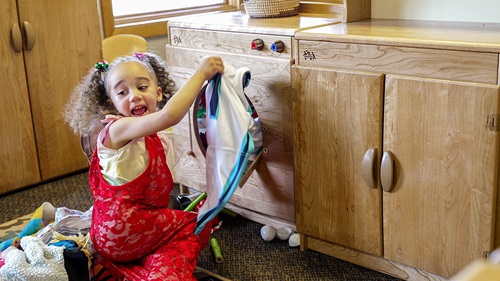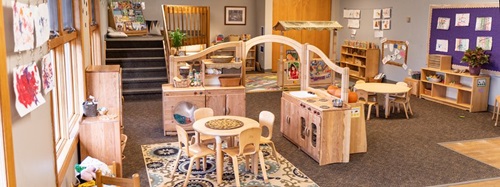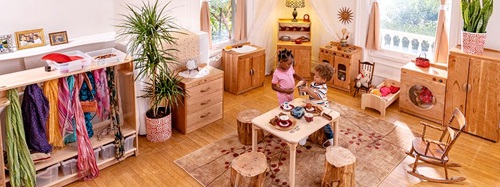The View From the Door
Entryways are an Essential Aspect of Environmental Design
| May 2011Early childhood environments that are engaging and responsive to the needs of children and professionals take into account the incredible diversity that is in each classroom. Not only is the classroom comprised of a variety of individuals with unique ways of viewing and interacting with the world, but all individuals bring with them their own developmental needs. A good environment, therefore, will meet this diversity of needs. Careful attention to all aspects of environmental design can support this important task.
ENVIRONMENTAL DESIGN
Where does environmental design begin? Much attention has been paid to classroom layout in early childhood programs: the placement of areas relative to one another, and learning center design. Although consideration of these variables is certainly important in designing appropriate environments for children, families, and staff, something can be gained by focusing on one small area of the room, and taking apart what that area might mean in the larger scope of children’s needs. By looking at one corner of the environment — the view from the door — many important aspects of environmental design can be examined and highlighted.
What can be learned from the view from the door, or entryway, as these areas are typically referred to? Environmental design is an important part of supporting children’s engagement, motivation, and learning. In order for children to feel motivated, they need to feel safe and secure in the early childhood environment, and an important part of this safety and security is how well children’s transitions from the outside world are supported. The view from the door can give important information about what the classroom is all about. The classroom impacts children, families, and staff as they step through the door.
The view from Linda, Marian, Carrie, and Karissa’s door. Twelve busy infants and toddlers fill Linda, Marian, Carrie, and Karissa’s classroom; and developmentally, these children have incredibly varied needs. Overall goals of the classroom include supporting the children’s needs for security, autonomy, and independence; and the teachers have placed specific materials and activities at the door that opens into the room to support these goals.
WHAT DO YOU SEE AS THE DOOR SLOWLY OPENS?
Many of the young children (and parents!) who enter through the door need just a bit more time, a few more snuggles, before they are ready to venture out into other areas of the room. It is here that parents and teachers can cuddle up with children over their choice of a good book, located next to the couch in an inviting straw basket. On the left is a small couch, worn by the use of its many occupants, and adorned with a floral — of course washable — cover. Some children prefer an overview of the activities in the room, so the books are put aside in favor of conversation that labels the room’s activities:
“Oh, look! Jessica is playing in the dirt table!”
“It looks like Juanita is enjoying painting!”
“I see that John and Jackie are playing with the dolls.”
From this point of security, physical contact and language allow the child time to transition into the classroom, and provide support as children prepare for the day ahead.
Other children enter into the room full speed ahead, ready to jump right in! For these children, the variety of inviting objects — scarves, rocks, an aquarium — are there for them to explore. Parents seem to appreciate the time these engaging activities allow them to sign in their children, to share information about their child with the classroom teacher, and to store the child’s belongings in his or her cubby. The parent can then guide the child into the classroom, and devote time to saying goodbye.
The view from Wendy, Kristin, and Margaret-Jo’s door. For Wendy, Kristin, and Margaret-Jo’s busy classroom of 20 preschoolers, the placement of materials at the door supports the children’s developing needs for independence and initiative, as well as their developing literacy skills.
- Cubbies are arranged so that children can place their own belongings in the designated spots using the picture and name labels to find their cubbies.
- Objects of high-interest — a sand and water table filled with cotton balls and measuring cups and the class guinea pig, Princess, are placed near the door to support entry into the room. These activities support children’s transitions into the room, and allow teachers the time to greet children and converse with parents as they arrive.
- The most recent topic web is posted near the entrance to the classroom to remind children of ideas they are currently exploring.
- The day’s schedule is placed on an easel, with the written word and pictorial representations conveying the day’s activities.
- The Sign-In Table is placed near the doorway. After being greeted by their teachers and separating from their parents, the children proceed (sometimes with gentle reminders) to the Sign-In Table where they select their laminated nametag from the pile on the table, and place it in the nearby basket. The children know that this indicates that they are “here,” and it is from this ritual that they jump enthusiastically into their day.
WHAT CAN WE LEARN FROM THESE VIEWS FROM THE DOOR?
There are two very distinct views from the doors of these rooms, supporting the developmental needs of two distinct classroom communities. But despite the differences in entryway design, these rooms have important similarities that we can use as guidelines for developing entrances to rooms that are responsive to and supportive of children’s, families’, and teachers’ needs.
Entryways should be designed to support children’s varied developmental needs. For infants and toddlers, these needs include security and autonomy/independence, and for older children, the need to display initiative is added to the mix. Entryways should provide children with opportunities to develop and maintain relationships, to help them to interact with their environment, and to feel the impact of these interactions.
Entryways should be designed to support children’s varied needs for social interactions. Children learn from their peers as well as from adults in their lives. Entryways should allow not only for adult-child interaction, but should provide opportunities for children to gather, connect, and support one another as they begin their day.
Entryways should be designed to support children’s needs for experimentation. Children construct knowledge through active interaction with their environment. In addition to being a transition spot, entryways are also prime spots for experimentation to occur. Placing high-interest activities at the door supports children’s engagement with — and transition into — the classroom.
Entryways should support classroom community. Dynamic classroom communities share common characteristics; they promote a sense of belonging as an individual, as a member of a group, and highlight the value of cooperation and respectful interactions. Children should have opportunities to recognize their individuality, as well as their commonality. The strategic placement of pictures — of the children, their families, and the class — can provide rich opportunities for conversations and reflection, and convey the sense of belonging — critical to functioning as an essential member of the group.
ADDRESSING COMMON OBSTACLES
The same careful attention that is given to overall classroom design needs to be extended to this entry area. As with overall classroom design, there are some pitfalls to avoid in designing entryways.
Traffic jams. The appeal of high-interest activities and opportunities for children, families, and teachers to gather need to be tempered by a need for balance in the environment. Just as spending time in a traffic jam can produce anxiety in adults, classroom entryways that are cluttered — with people and objects — can produce anxiety. Think of the entryway as one zone of the classroom — not just a small space where the door opens, but as an area whose design needs to support various goals. The use of space and thoughtful placement of materials are critical. Ongoing observation and redesign can ensure that this classroom area is meeting its intended goals.
Sensory overload. Imagine walking into your place of employment and immediately being bombarded by sights, sounds, and people — all pressing upon you for your attention. Careful attention to the temperamental needs of individuals within the classroom can ensure that there is space at the door for the child who wishes to hang back and observe prior to engaging in the classroom, as well as the child who bursts through the door, looking for action. Again, observation is essential. The design of this area should be viewed as a work-in-progress.
HOW TO BEGIN
How can you start developing entryways that meet these varied goals? Next time you enter your classroom, get down on your knees — so you are viewing the classroom from children’s eye level — and take a good look around:
- What catches your interest?
- What activities might help you cross the threshold and enter into the larger environment?
- Are there children who need extra snuggles before full entry? Is there space to accommodate this?
- Are there objects in your immediate view that might serve as rich conversational pieces, helping children to make the transition into the larger environment?
Next, think of yourself as a parent, and identify all the things parents might need to do when entering the class:
- Are places for children’s belongings clear, organized, and accessible?
- Is there a spot where parents can engage in conversations with other adults — particularly the teacher — without needing to step over other people or objects?
- Is there space that recognizes that parents often need extra snuggles before they transition out of the room?
Finally, think of your own professional needs: - Does the entryway provide you with opportunities to converse with parents and children?
- Is there space for you to support a child transitioning into the room?
Many of the factors discussed as critical in the development of responsive entryways carry over to all areas of the classroom. It is important to keep in mind that the view from the door is the first glimpse children, families, and teachers have into the classroom environment. You want this view to convey all that the environment has to offer and to welcome everyone inside.
Reprinted with permission from Exchange magazine.
Visit us at www.ChildCareExchange.com or call (800) 221-2864.

